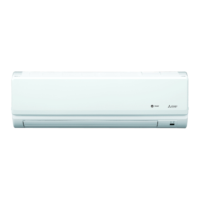Why do I hear a flowing water sound from my Mitsubishi Electric TRANE NTXCKS09A112A Heat Pump?
- WwhansenSep 6, 2025
These sounds can be heard when refrigerant is flowing in the Mitsubishi Electric Heat Pump or when the refrigerant flow is changing.

Why do I hear a flowing water sound from my Mitsubishi Electric TRANE NTXCKS09A112A Heat Pump?
These sounds can be heard when refrigerant is flowing in the Mitsubishi Electric Heat Pump or when the refrigerant flow is changing.
Why do I hear a cracking sound from my Mitsubishi Electric TRANE NTXCKS09A112A?
These sounds can be heard when parts rub against each other due to expansion and contraction from temperature changes in your Mitsubishi Electric Heat Pump.
Why does my Mitsubishi Electric Heat Pump make the room smell bad?
The indoor unit draws in air that contains gases produced from the walls, carpeting, and furniture as well as odors trapped in clothing, and then blows this air back into the room.
Why is white mist coming from my Mitsubishi Electric TRANE NTXCKS09A112A?
If the indoor temperature and humidity are high, a white mist or vapor may be emitted from the indoor unit of your Mitsubishi Electric Heat Pump when operation starts. Also, during defrosting mode, cool airflow may blow down and appear like a mist.
Why is water coming from my Mitsubishi Electric TRANE NTXCKS09A112A outdoor unit?
During cooling mode, water may form and drip from the cool pipes and joints of your Mitsubishi Electric Heat Pump. During heating mode, water may form and drip from the heat exchanger. During defrosting mode, water on the heat exchanger evaporates, and water vapor may be emitted.
What does “ ” mean on my Mitsubishi Electric Heat Pump remote?
During central control, “ ” appears in the remote controller display, and air conditioner operation cannot be started or stopped using the remote controller.
| Brand | Mitsubishi Electric |
|---|---|
| Model | TRANE NTXCKS09A112A |
| Category | Heat Pump |
| Language | English |
Explains text/illustration symbols, general warnings, and cautions for safe operation and handling.
Lists key components of the indoor unit, including fan, vane, filter, and controller settings.
Details the wired remote controller's interface, buttons like ON/OFF, Menu, and function buttons.
Explains display modes and the meaning of various icons on the remote controller.
Identifies and explains the functions of buttons and indicators on the wireless remote controller.
Provides notes for wireless remote controller use, battery installation, and turning the unit ON/OFF.
Guides on selecting operation modes and adjusting the desired temperature.
Details how to adjust fan speed and navigate menus for airflow direction settings.
Explains vane positioning, fixed air direction, and automatic swing settings.
Provides detailed steps for setting manual vane angles for both wired and wireless remote controllers.
Explains configuration of the 3D i-See sensor for air distribution, energy saving, and seasonal airflow.
Details energy saving options like occupancy detection and auto-OFF functions for enhanced efficiency.
Explains seasonal airflow settings that adjust vane movement based on operating mode and thermostat status.
Guides users on setting up a weekly schedule for automatic operation patterns, including on/off times and temperatures.
Provides instructions on how to check filter status, clean filters, and reset the filter indicator.
Explains how to operate the unit using emergency buttons on the grille when the remote controller is unavailable.
Addresses common problems like poor heating/cooling, airflow issues, and unusual sounds, offering troubleshooting advice.
Provides solutions for specific error messages, display issues, noise, and connectivity problems.
Advises on suitable and unsuitable locations for installing the air conditioner, including safety precautions.
Details safety warnings for installation, electrical work, grounding, and maintenance by qualified personnel.
Presents key technical specifications for different models, including power, dimensions, airflow, and noise levels.












